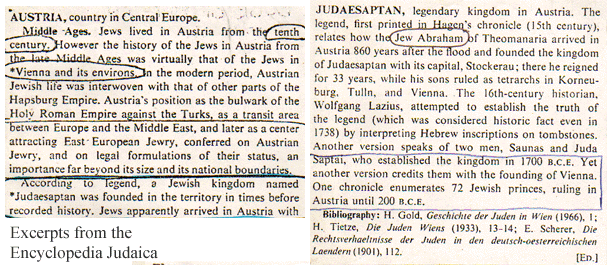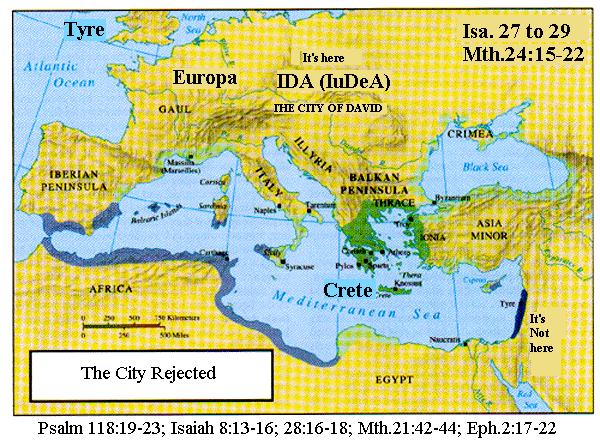THE VEDIC PEOPLE
VEDIC CREATION MYTH...The Rig Veda is a collection
of more than a thousand hymns composed in northwest India about 1500BC, in
an archaic form of Sanskrit, an ancient Indo-European language. In addition
to this canon, numerous myths appear in commentaries composed a few centuries
later and known as the Brahmanas. These texts were not committed to
writing for many centuries after their composition, but oral tradition preserved
them and later Hindu literature draws heavily upon their characters and events.
The central myth of the Rig Veda is the myth of creation.
This is described in several different ways. Often the universe is said to
have come into being OUT OF CHAOS, (compare Genesis 1:2),
when a god--Indra, king of the gods and god of rain, or Vishnu, a solar deity--SEPARATED
HEAVEN FROM EARTH. (East from West, see Genesis 10:25).
Then the Sun arose AND FROM THAT SPOT, THE NAVEL OF THE EARTH, A GREAT PILLAR
WAS ERECTED TO PROP APART HEAVEN AND EARTH. THIS PILLAR IS THE AXIS OF THE
WORLD.
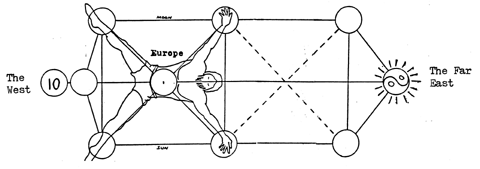
THERE WERE NOW THREE WORLDS: HEAVEN (The East),
EARTH (The West), AND THE INTERVENING (Middle
Earth, the Sea, where the Great Dragon, Leviathan, lay hidden). Vishnu
is said to measured out (and thus, in the Vedic view, to have created) these
three worlds with three great strides. (The last two are recorded
at Revelation 10:2). Although there are some obscure hints of an underworld,
little is said about this part of the universe in the Rig Veda. The
Sun travels below the earth at night to return to the east by morning, and
this mirror-image world (a world of brightness) is ruled by Varuna, (the Clear-Bright
Sky)...
And they saw the God of Israel: and there was under
his Feet as it were a paved work of a sapphire (Sefirot)
stone, and as it were the Body of Heaven in his clearness...(Exodus
24:10).
Second to the Vedic creation myths in importance and frequency
are the myths of the eternal battle between gods and demons....In the Rig
Veda, the demons are often confused with the human enemies of the...Indo
Aryans, and Indra as king of the gods simultaneously defeats the human foes,
destroys the threatening demons and sets free the creative power of the universe.
The arch-enemy of Indra is Vritra, A GREAT SERPENT WHO LIES COILED ABOUT THE
WORLD MOUNTAIN AT THE NAVEL OF THE EARTH, holding back the waters. Indra pierces
Vritra, lets loose the rains and shatters the mountains. This act sets free
the cows (the Feminine principle) who were kept prisoner in the World-Mountain,
and released the Sun (the True Light), which was held fast within the Rock
of the underworld night. The slaughter of the dragon (understand the
symbolism here, see chapter Three), is an act of creation
as well as destruction, yet another way of firmly establishing and steadying
Heaven and Earth in their proper places. Mythology, An Illustrated
Encyclopedia, by Richard Cavendish, pp.15, 16.
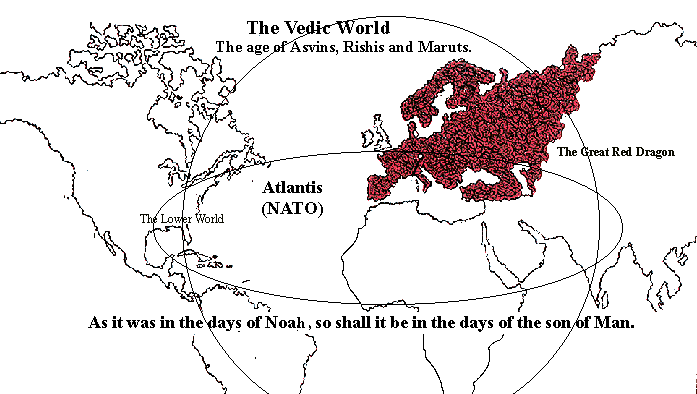
But as the days of Noah were, so shall the coming of the
Son of man be.
For as in the days that were before the flood they were
eating and drinking, marrying and giving in marriage, until the day that Noah
entered into the ark.
And knew not until the flood came, and took them all away;
so shall the coming of the Son of man be...(Matthew
24:37-39).
__________
And the waters which thou sawest, where the whore
(world religion herself) sitteth, are peoples, and
multitudes, and nations, and tongues...(Revelation 17:15).
__________
"In the eighteenth generation
walled cities were built, armies were organized and armed (the spirits
of Cain and Nimrod were abroad in the land),
judges and laws were sanctioned, temples were built, and the princes of the
nations were adored as gods.
In the nineteenth generation the
descendants of him who was cursed after the flood (Canaan),
going beyond their proper bounds which they had obtained in the Western regions,
drove into the Eastern lands those who had obtained the Middle portion of
the world, and pursued them as far as Persia, while themselves violently took
the country from which they expelled them."
Recognition of Clement xxxi.
__________
"O Solon, Solon, you Greeks are
all children, and there is no such thing as an old Greek. 'What do you mean
by that?' inquired Solon. 'You are all young in mind,' came the reply: 'you
have no belief rooted in the old tradition, and no knowledge hoary with age.
And the reason is this. There have been and will be many different calamities
to destroy mankind, the greatest of them by fire and water, lesser ones by
countless other means. Your own story of how Phaethon, child of the sun, harnessed
his father's chariot, but was unable to guide it along his father's course
and so burnt up things on the earth and was himself destroyed by a thunderbolt,
is a mythical version of the truth that there is at long intervals a variation
in the course of heavenly and a consequent widespread destruction by fire
of things on the earth…
Our records tell how your city
checked a great power which arrogantly advanced from its base in the Atlantic
ocean to attack the cities of Europe and Asia. For in those days the Atlantic
was navigable. There was an island (a continent), opposite the strait which
you call (so you say) the Pillars of Hercules, an island larger than Libya
and Asia combined; from it travelers in those days could reach the other islands,
and from them the whole opposite continent which surrounds what can truly
be called the ocean. For the sea within the strait we are talking about is
like a lake with a narrow entrance; the outer ocean is the real ocean and
the land which entirely surrounds it is properly termed continent.
On this island of Atlantis had
risen a powerful and remarkable dynasty of kings, who ruled the whole island,
and many other islands as well and parts of the continent; in addition it
controlled within the strait, Libya (Africa) up to the borders of Egypt and
Europe as far as Tyrrhenia. This dynasty, gathering its whole power together,
attempted to enslave at a single stroke, your country and ours and all the
territory within the strait… At a later time there was earthquakes and floods
of extraordinary violence, and in a single dreadful day and night all your
fighting men were swallowed up by the earth, and the island of Atlantis was
similarly swallowed up by the sea and vanished; this is why the sea in that
area is to this day impassable to navigation, which is hindered by mud just
below the surface, the remains of a sunken island." (see Job 41:30).
The Timaeus, Plato.

I will declare the mighty deeds of Indra (YHVH),
the first that he achieved, the Thunder-wielder. HE SLEW THE DRAGON, then
disclosed the waters, and cleft the channels of the mountain torrents.
He slew the Dragon lying on the mountain: his heavenly
bolt of Thunder Tvastar fashioned...
When, Indra, thou hadst slain the Dragon's firstborn,
(the children of Cain),
and overcome the charms of the enchanters. Then giving life to the Sun and
Dawn and Heaven, thou foundest not one foe to stand against thee.
Indra with his own great and deadly Thunder smote in pieces
Vrtra, worst of Vrtras. As trunks of trees, what time the axe hath felled
them, low on the earth so lies the prostrate Dragon...(Rig
Veda I.XXXII.1-5).
__________
Thus John the Baptist, son of the Torah, student of the ancient
Vedas, proclaimed: And think not to say within yourselves, We have Abraham
(Brahma) to our father: for I say unto you, that
God is able of these stones (these very precepts of the
Torah), to raise up children unto Abraham.
And now also is the axe laid to the Root of the Trees:
therefore every tree which bringeth not forth good fruit is hewn down, and
cast into the Fire...(Matthew 3:9, 10).
__________
All sacred songs have magnified Indra expansive as the
sea. The best of Warriors born on cars (chariots),
the Lord, the very Lord of Strength.
Strong in thy friendship, Indra, Lord of Power and Might,
we have no fear...
The wise beheld this deed of Thine: now go beyond their
eulogies.
Our songs of praise (open the Book
of the Psalms, as well as the Hymns of the Essenes) have glorified
Indra who ruleth by His might. Whose precious gifts in thousands come, yea,
even more abundantly...(Rig Veda I.XI.1, 7,8).
__________
Those who by Law uphold the Law, Lords of the shining
light of Law, Mitra I call, and Varuna.
Let Varuna be our chief defense, let Mitra guard us with
all aids... (RV.I.XXIII.5,6).
__________
And he took the book of the covenant, and read in the
audience of the people: and they said, All that the Lord hath said will we
do, and be obedient.
And Moses took the blood, and sprinkled it on the people,
(seven times), and said, Behold the blood of
the covenant, which the Lord hath made with you concerning all these words.
Then went up Moses and Aaron, Nadab, and Abihu, and Seventy
of the elders (the Rishis)
of Israel:
And they saw the God of Israel: and there was under his
Feet as it were a paved work of Sapphire (Sefira)
stone, AND AS IT WERE THE BODY OF HEAVEN IN HIS CLEARNESS....(Exodus 24:7-10).
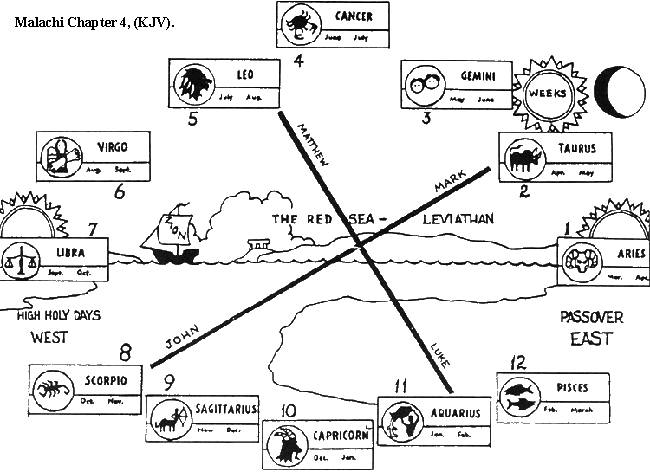
The God of Israel, Immortal, Invisible...1 Timothy 1:17
(KJV).
The point we have been reaching for throughout this work (please
see chapter 4 in The Commentary) is that Vedic civilization has its roots,
as does the entire Judaeo-Christian-Islamic tradition, in the Garden of Eden
here at the Western ends of the earth (where the Great Ganges flows from the
Lotus Feet of the supernal figure of Brahma-Vishnu-Shiva [see Isaiah 6:1-3]
onto the plains of India)...
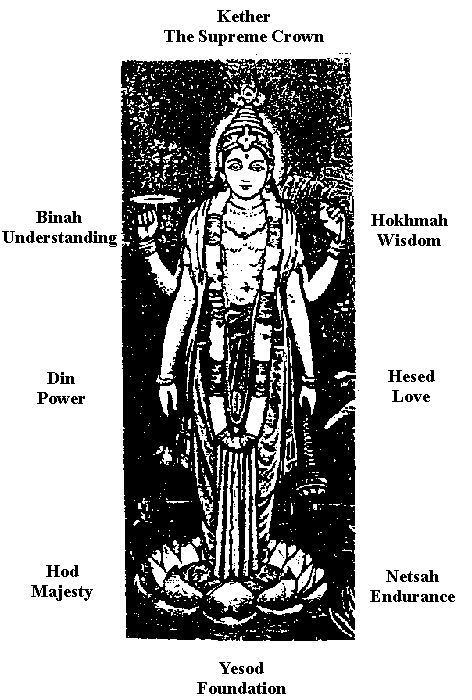
Hindus particularly choose this
river for holy rituals because the merits of works performed here become manifold
in their results. Another name of Ganga is Vishnupadi, the One flowing from
the Foot of God Vishnu. Vishnu Paran says that Ganga encloses Brahma's Great
City situated on Mount Meru (the moveable Mount Zion)
and then divided into Four mighty rivers flowing in Four directions. Gods
and Goddesses of India, New Delhi, pp.113-116.
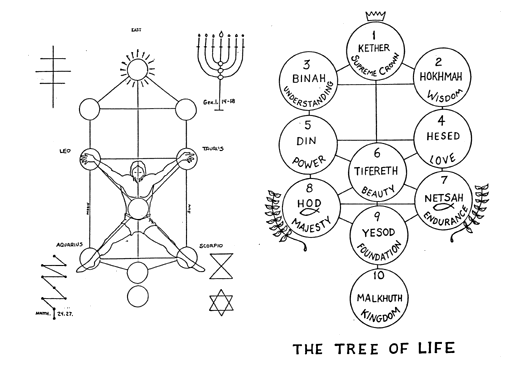
There is a Fig Tree in ancient
story, the Giant Aswaitha, the Everlasting, Rooted in Heaven, its branches
earthward. Each of its leaves is a song of the Vedas, and he who knows it
knows all the Vedas.
Downward and upward its branches
bending are fed by the Gunas (the interplay of three worlds-the Higher,
the Lower, and the In-between).
The buds it puts forth are the
things of the senses. Roots it also has reaching downwards into this world,
the roots of man's actions. (see Ephesians 3:9-19).
What its form is, its end and
beginning, its very nature, can never be known here (in India).
Bhagavad Gita XV.
__________
"Now the garden was watered
by One river which ran round about the whole earth, and it was parted into
Four parts. And Phison, which denotes a multitude, running into India, makes
its exit into the sea, and is by the Greeks called Ganges.
Euphrates also, as well as Tigris,
goes down into the Red Sea, (which we shall see, according to this
purely apocryphal, but factual account of the four rivers, eventually becomes
the Pacific Ocean, as well as all the other oceans of the world. For the
Red Sea is where the great Red Serpent lives, and this creature comprises
all the peoples and nations that inhabit the body of the great Continent,
Leviathan). Now the name Euphrates,
or Prath, denotes either a dispersion, or a Flower; By Tigris, or Diglath,
is signified what is swift with narrowness (as these mysteries being
swept through the narrow place at the center of the Oracle, from West to
East in those ancient times)…
And Geon runs through Egypt,
and denotes what arises from the East, which the Greeks call Nile."
Josephus's Antiquities I.I.3.
Thus we would see that all the hymns of the Rig Veda, which
sing the praises of the Only One God, but in Their various manifestations as
Agni and Indra, as Mitra and Varuna, find their meanings in the events of those
Atlantean wars that were waged between the sons of Darkness (the children of
Cain) and the forces of God (the other non-Adamic powers of the earth) in the
time of Noah. They also find their meanings in the sentiments of those children
of Light who were delivered out of these wars by the exploits of Indra (Great
Indra who revealed Himself in the collective form of all the powers of the earth
in those times, and then later in the letters of the Tetragrammaton, YHVH, in
the time of Moses). The hymns of the Vedas were first composed by these adepts
in the world-mystery who appeared at the same time in history as the children
of Darkness, but in the spirit of Abel instead of Cain. These ASVINS
as they are known in the Rig Veda were the first true monotheists, and therefore
the world's first true pacifists. (Every true monotheist must at the same time
be, or immediately become a true pacifist, for the very simple reason that the
One God is present in all things, and in every human event, and therefore more
Terribly Present in those forces that others in God's name so erroneously perceive
to be their mortal enemies...see Romans 13:1-5). Thus these Asvins (these
sons of Seth, and later Shem) came into the East out of the Northwest, not as
warring conquerors in the literal sense but as peaceful people (peaceful warriors)
fleeing the ravages of war itself. They will become the forerunners of those
orders of Rishis and Maruts (those Merkabah mystics), who will return to the
center of this great Mystery again in the time of Abraham, and then again in
the time of Christ:
Now morning with her earliest light shines forth, dear
Daughter of the Sky: High Asvins, I extoll your praise,
SONS OF THE SEA, mighty to save, discoverers of riches,
ye Gods with deep thought who find wealth.
Your giant coursers hasten on over the region in all flames,
When your car (chariot) flies with winged steeds...
Ye have regard unto our hymns, Nasatyas, thinking of our
words: Drink boldly of the Soma juice.
Vouchsafe for us, O Asvin Pair, such strength as, with
attendant light, may through the darkness carry us.
Come in the ship of these our hymns to bear you to the
hither shore. O Asvins harness ye the car (the chariot).
The heaven's wide vessel is your own: on the flood's shore
(at the edge of war) your chariot waits...
The Path of Sacrifice was made to travel to the farther
goal: the Road of Heaven was manifest...(RV.I.XLVI).

Ye who observe this day be with us even Thrice: Far Stretching
is your bounty, Asvins and your course. To you, as to a cloak in winter, we
cleave close: you are to be drawn nigh unto us by the wise.
Three are the fellows in your honey-bearing chariot, that
travels after Soma's loved one, as all know. THREE ARE THE PILLARS set upon
it for support: Thrice journey ye by Night, O Asvins, Thrice by Day...
And Thrice vouchsafe us store of food with plenteous strength,
at Evening, O ye Asvins, and at break of Day...
Thrice, O ye Asvins, bring to us abundant wealth: Thrice
in the God's assembly, Thrice assist our thoughts...
Thrice, Asvins, grant to us the heavenly medicines, Thrice
those of earth and Thrice those that the waters hold...
Thrice are ye to be worshipped day by day by us: Thrice
O ye Asvins, ye travel round the earth. (Chariot) born from far away, O ye
Nasatyas, come like vital air to bodies, come ye to the Three.
Thrice O ye Asvins, with The Seven Mother Streams; Three
are the jars, the Triple Offering is prepared. Three are the worlds, and moving
on above the sky ye guard the firm-set vault of heaven through days and nights...
When will ye yoke the mighty Ass that draws it, to bring
to our sacrifice. Nasatyas?...(Rig Veda 1.XXXIV).
"The Asvins seem to have been
a puzzle even to the oldest Indian Commentators...Next in order are the deities
whose sphere is in heaven; of these the Asvine are the first to arrive...Who
then are these Asvins? Heaven and earth some say; Day and Night say others;
The Sun and Moon, say others...The two Asvins (Adam/Manu--Male and Female),
though, like the ancient interpreters of the Vedas, we are by no means agreed
as to the conception of their character, hold nevertheless a perfectly distinct
position in the entire body of the Vedic deities of Light. They are the earliest
bringers of light in the morning sky, who in their chariots (see the
commentary on Ezekiel chapter 1 in chapter four of this work)
hasten onwards before the Dawn, and prepare the way for her." Sacred
Writings, The Rig Veda, Translated by Ralph T. H. Griffith, Book Of
The Month Club, New York. Notes to Hymn III, (p.2).
__________
"The Indian historical tradition
without any doubt or difficulty accepts the antiquity of the Vedas. It accepts
the date of Rgveda Samhita to be 4500 B.C. as determined by Tilak and the
composition of some of its earlier hymns as going back to 6500 B.C. or even
to greater antiquity. (This protraction of historical events, beyond
the time of Adam about 120 Jubilees, or roughly 6,000 years ago, is a common
practice among some native historians in their attempts to rescue their own
histories from the hands of Western scholarship and even from the Western
tradition itself. Nevertheless, the author goes on to say):
The Indian historical tradition
as handed down to to us by the Epics, the Puranas, the day-to-day utterance
of the Sankalpa, show that Salivahana era did start from 78 A.D. and that
the Kaliyuga started from 3102-1 B.C. The Yudhisthirabda...is still being
observed in Kashmir. That it starts from 3076 B.C. is unquestionably accepted
by the Indian people.
But the advent of Western Indologists
on the scene has distorted beyond all imagination all these beliefs so far
held by the Indians. Max Muller's determination of Indian chronology...now
holds the field. But that this contradicts their own discoveries is now becoming
more and more apparent. The consensus is now evolving among the Western Indologists
including Wheeler about the date of the Indus Valley civilization as about
3100 B.C. or even earlier. Their pet-theory about the hordes of the Aryan
invaders coming down on the peace-loving Indus Valley people in their chariots
about 1800 B.C. and destroying their civilization by arson, loot and murder
has no support either in literature or in archaeology. In passing, one can
note here that the passes in the Hindukush and Karakoram ranges on the Indo-Afghan
border, are even today unsafe for chariots to cross. It is difficult to believe
that the 'Aryan invaders' entered through these passes with their chariots
in those remote days.
The Indian indologists...are accepting
the Bharata war as a historical event which took place around the beginning
of the Kali era starting from 3102-1 B.C..These assumptions necessarily take
the date of the Rgveda Samhita at least a few centuries prior to the start
of the Kali era. It will be seen how the Rgveda itself proves that the Vedic
people belonged to THE SAPTA--Sindu Pradesha, i.e. present day Pakistan and
the Punjab and Kashmira states of Bharata and some regions west of the river
Sindhu extending up to the Caspian Sea and Caucasus and Pamir mountains, and
the question of 'Aryan' invasion of Bharata is nothing but a figment of imagination
of these indologists." Bhishma's Study of Indian History and Culture,
Volume 1, Beginnings of Life, Culture and History, by S.D. Kulkarni; Bombay,
1988. pp.107-109.
